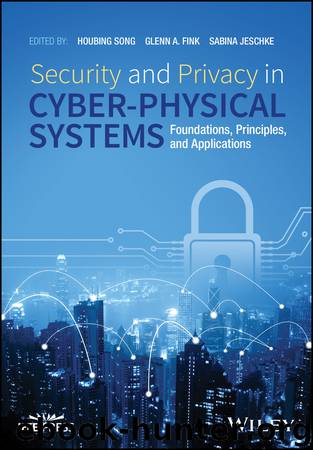Security and Privacy in Cyber-Physical Systems by Song Houbing Fink Glenn A. Jeschke Sabina & Glenn A. Fink & Sabina Jeschke

Author:Song, Houbing,Fink, Glenn A.,Jeschke, Sabina & Glenn A. Fink & Sabina Jeschke [Неизв.]
Language: eng
Format: epub
ISBN: 9781119226062
Publisher: John Wiley & Sons, Inc.
Published: 2017-09-04T00:00:00+00:00
10.3.2 A Policy-Based Establishment of Cloud Robot Networks
We present an integration of the PEACE framework [10, 13] and ABE to secure cloud robot networks. We first provide an overview of the PEACE framework in this section.
Robots deployed onto an area/site are tasked to form a robot network community in order to exchange services and share resources among themselves, so that they can collaboratively complete the tasks assigned to them. Policies are used to specify admission criteria for joining the robot community, so that only authorized robots are granted access. The community is specified by a doctrine, a policy specification that consists of a set of rules defining the attributes (credentials) that robots and other participants such as mobile devices must possess to be eligible to join the community. The doctrine also defines the privileges of participants to access services and it is made available to all members in the community. The doctrine can be encrypted in order to protect the privacy of the policies and rules.
The life cycle of a community is divided into three phases: bootstrapping phase, operational phase, and dissolving phase. In the bootstrapping phase, participants must agree on a common doctrine and they must be able to authenticate each other in order to ascertain their eligibility to join the community. Once the community is formed, there is a need for a membership management service to maintain the community membership. A coordinator, typically located in the cloud, is selected to enforce the membership admission policies.
In the operational phase, the dynamic nature of robot networks means that participants may frequently join and leave the community. Management protocols are needed to facilitate participants joining and leaving, dissemination of membership information, and dealing with network partitioning. In this phase, the coordinator uses a lightweight protocol to guarantee the authenticity and integrity of a revocation list broadcast to all members. The access control leverages ABE to enforce the access control policies in the community (see Section 10.4.6). Lastly, the dissolving phase provides a controlled disbanding of the community.
Download
This site does not store any files on its server. We only index and link to content provided by other sites. Please contact the content providers to delete copyright contents if any and email us, we'll remove relevant links or contents immediately.
Effective Threat Investigation for SOC Analysts by Yahia Mostafa;(7395)
Practical Memory Forensics by Svetlana Ostrovskaya & Oleg Skulkin(7114)
Machine Learning Security Principles by John Paul Mueller(7079)
Attacking and Exploiting Modern Web Applications by Simone Onofri & Donato Onofri(6743)
Operationalizing Threat Intelligence by Kyle Wilhoit & Joseph Opacki(6721)
Solidity Programming Essentials by Ritesh Modi(4529)
Microsoft 365 Security, Compliance, and Identity Administration by Peter Rising(4114)
Operationalizing Threat Intelligence by Joseph Opacki Kyle Wilhoit(3865)
Learn Computer Forensics - Second Edition by William Oettinger(3606)
Building a Next-Gen SOC with IBM QRadar: Accelerate your security operations and detect cyber threats effectively by Ashish M Kothekar(3581)
Future Crimes by Marc Goodman(3533)
Blockchain Basics by Daniel Drescher(3507)
Mastering Azure Security by Mustafa Toroman and Tom Janetscheck(3472)
Mastering Python for Networking and Security by José Manuel Ortega(3452)
Incident Response with Threat Intelligence by Roberto Martínez(3345)
The Code Book by Simon Singh(3074)
Mastering Bitcoin: Programming the Open Blockchain by Andreas M. Antonopoulos(2981)
Mobile App Reverse Engineering by Abhinav Mishra(2959)
From CIA to APT: An Introduction to Cyber Security by Edward G. Amoroso & Matthew E. Amoroso(2861)
